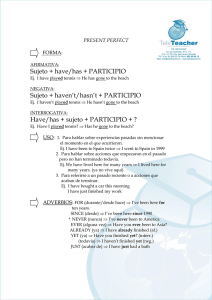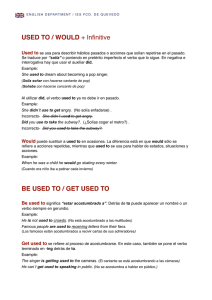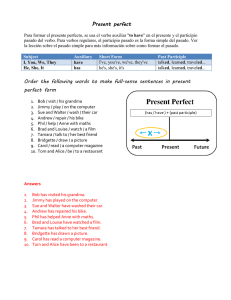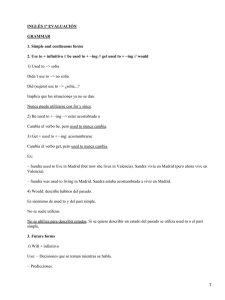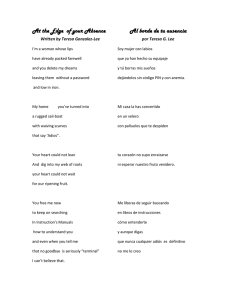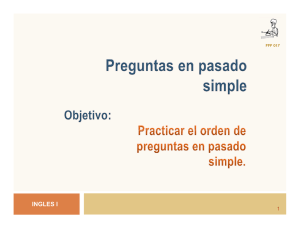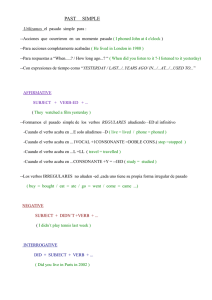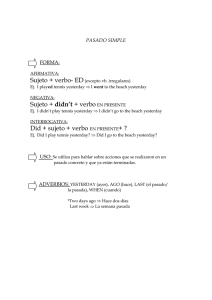I`m thirsty Water boils at 100 degrees She works in New York I often
Anuncio
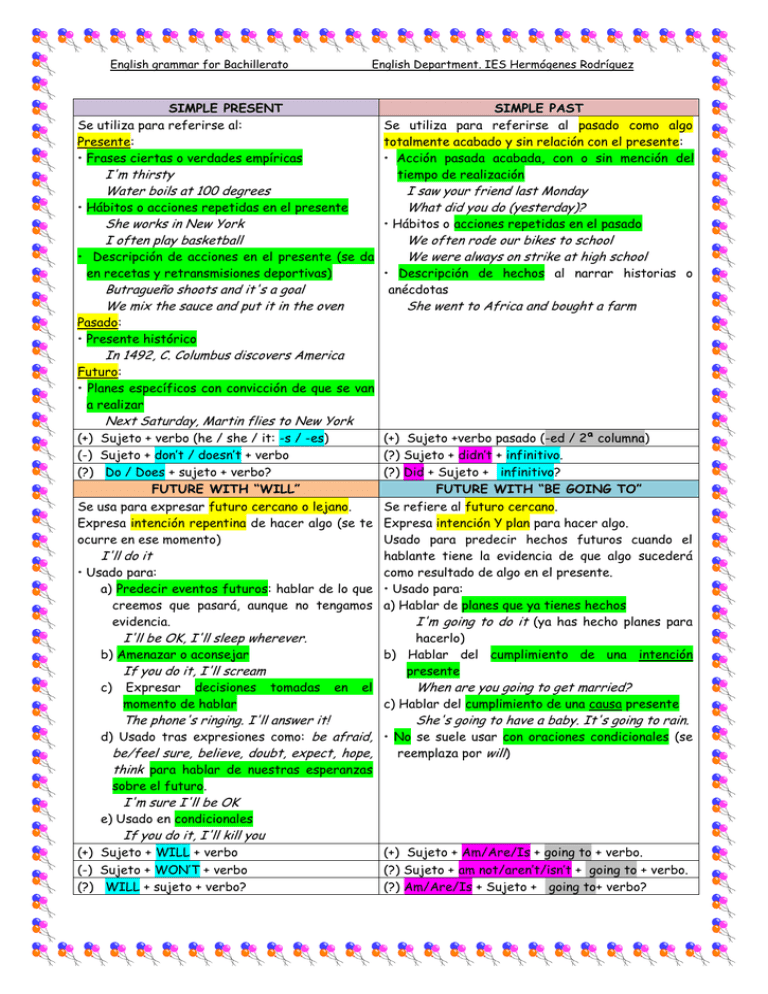
English grammar for Bachillerato English Department. IES Hermógenes Rodríguez SIMPLE PRESENT Se utiliza para referirse al: Presente: • Frases ciertas o verdades empíricas I'm thirsty Water boils at 100 degrees • Hábitos o acciones repetidas en el presente She works in New York I often play basketball SIMPLE PAST Se utiliza para referirse al pasado como algo totalmente acabado y sin relación con el presente: • Acción pasada acabada, con o sin mención del tiempo de realización I saw your friend last Monday What did you do (yesterday)? • Hábitos o acciones repetidas en el pasado We often rode our bikes to school We were always on strike at high school • Descripción de acciones en el presente (se da en recetas y retransmisiones deportivas) • Descripción de hechos al narrar historias o Butragueño shoots and it's a goal anécdotas We mix the sauce and put it in the oven Pasado: • Presente histórico She went to Africa and bought a farm In 1492, C. Columbus discovers America Futuro: • Planes específicos con convicción de que se van a realizar Next Saturday, Martin flies to New York (+) Sujeto + verbo (he / she / it: -s / -es) (+) Sujeto +verbo pasado (-ed / 2ª columna) (-) Sujeto + don‘t / doesn‘t + verbo (?) Sujeto + didn‘t + infinitivo. (?) Do / Does + sujeto + verbo? (?) Did + Sujeto + infinitivo? FUTURE WITH “WILL” FUTURE WITH “BE GOING TO” Se usa para expresar futuro cercano o lejano. Se refiere al futuro cercano. Expresa intención repentina de hacer algo (se te Expresa intención Y plan para hacer algo. ocurre en ese momento) Usado para predecir hechos futuros cuando el I'll do it hablante tiene la evidencia de que algo sucederá • Usado para: como resultado de algo en el presente. a) Predecir eventos futuros: hablar de lo que • Usado para: creemos que pasará, aunque no tengamos a) Hablar de planes que ya tienes hechos evidencia. I'm going to do it (ya has hecho planes para I'll be OK, I'll sleep wherever. hacerlo) b) Amenazar o aconsejar b) Hablar del cumplimiento de una intención If you do it, I'll scream presente c) Expresar decisiones tomadas en el When are you going to get married? momento de hablar c) Hablar del cumplimiento de una causa presente The phone's ringing. I'll answer it! She's going to have a baby. It's going to rain. d) Usado tras expresiones como: be afraid, • No se suele usar con oraciones condicionales (se be/feel sure, believe, doubt, expect, hope, reemplaza por will) think para hablar de nuestras esperanzas sobre el futuro. I'm sure I'll be OK e) Usado en condicionales If you do it, I'll kill you (+) Sujeto + WILL + verbo (-) Sujeto + WON‘T + verbo (?) WILL + sujeto + verbo? (+) Sujeto + Am/Are/Is + going to + verbo. (?) Sujeto + am not/aren‘t/isn‘t + going to + verbo. (?) Am/Are/Is + Sujeto + going to+ verbo? English grammar for Bachillerato English Department. IES Hermógenes Rodríguez DIFERENCIAS ENTRE EL PASADO SIMPLE Y EL PRESENTE PERFECTO 1. I saw your friend (this morning): AHORA es por la tarde (la mañana se considera PASADA) 2. I have seen your friend today: HOY no se ha acabado En los siguientes ejemplos, analiza: ¿Cuál se refiere a un pasado más cercano? ¿Cuál se puede completar con la expresión ‗ a few years ago‘? 1. Graffiti has appeared on the walls of our town 2. Graffiti appeared on the walls of our town DIFERENCIAS ENTRE EL FUTURO CON “WILL” Y CON “BE GOING TO” Ambos son usados para predicciones sobre el futuro y son bastante parecidos, aunque no siempre son intercambiales. Por ejemplo comparemos las siguientes frases: - Predicción sin evidencia necesaria: They say women will be more equal by the year 2020 Things will change - Predicción con evidencia en el presente: The women in this factory are going to be sacked (el jefe me lo ha dicho) Things are going to change (he hecho movimientos para que las cosas cambien) Ambas se usan para intenciones, pero el futuro con will se refiere a decisiones distantes, y el futuro con be going to implica una intención y un plan. Aquí también lo podemos ver claramente: [The phone's ringing] Jane: I'll answer it! (se le acaba de ocurrir a Jane) Joe: Sorry? Jane: I said I was/am going to answer the phone! (Jane ya lo había planeado) PRESENT SIMPLE Se utiliza para referirse al: Presente: • Frases ciertas o verdades empíricas I'm thirsty Do you like oranges? The sun sets in the west She doesn‘t find you interesting enough! Water boils at 100 degrees • Hábitos o acciones repetidas en el presente She works in New York I often play basketball • Descripción de acciones en el presente (se da en recetas y retransmisiones deportivas) Butragueño shoots and it's a goal We mix the sauce and put it in the oven PRESENT CONTINUOUS Se utiliza para expresar: Presente: • Una acción que está ocurriendo en el momento de hablar. It's snowing! The children are sleeping Now I‘m living in Madrid • Hábitos temporales I'm taking swimming lessons Futuro: • Inmediato The party is starting in half an hour • Acciones futuras ya planeadas por el sujeto Pasado: • Presente histórico In 1492, Christobal Columbus discovers America Futuro: • Planes con convicción de que se realizarán Next Saturday, Martin flies to New York (+) Sujeto + verbo (he / she / it: -s / -es) (-) Sujeto + don‘t / doesn‘t + verbo (?) Do / Does + sujeto + verbo? (+) Sujeto + Am/Are/Is + verbo -ing. (?) Sujeto + am not/aren‘t/isn‘t + verbo -ing . (?) Am/Are/Is + Sujeto + verbo -ing? English grammar for Bachillerato English Department. IES Hermógenes Rodríguez PRESENT PERFECT Se usa para: • Acciones recientes con resultado presente (la evidencia se ve en el presente). Graffiti has appeared on our walls due to the strike • Acciones que comenzaron en el pasado y aún perduran. She's lived here all her life •Acciones recientes cuando el tiempo es indefinido (en interrogativas y negativas podemos usar yet) Have you seen the film yet? / No, I haven't seen it yet • Relato de experiencias desde el pasado hasta el presente (normalmente con ever/never). Have you ever seen Zappa perform? / No, I've never seen him / I saw him last year • Cuando hablamos de nuestra primera, segunda, etc. experiencia en algo. He has never driven a car / It‘s the first / second / third... time he has driven a car. (+) Sujeto + Have/Has + Participio pasado (-ed / 3ª columna). (-) Sujeto + Haven‘t/Hasn‘t + Participio pasado (-ed / 3ª columna). (?) Have/Has + Sujeto + Participio pasado (-ed / 3ª columna)? Expresiones más típicas: 1. FOR: Para expresar el tiempo que lleva ocurriendo algo (―durante‖ o ―desde hace‖ tanto tiempo). Sujeto + Have/Has + Participio pasado + For + Periodo de tiempo. I haven't smoked for three months. 2. SINCE: Para expresar un momento determinado en el pasado en el que comienza la acción (―desde‖) Sujeto + Have/Has + Participio pasado + Since + Punto en el pasado. I've played tennis since 1991. Otras expresiones: Delante del tiempo verbal: 3. STILL + VERBO NEGATIVO: „Aún / todavía‟: Se utiliza para expresar una acción que aún no se ha completado, pero que se esperaba que ya lo hubiese hecho; es enfático. Forma: Sujeto + Still + Haven‘t/Hasn‘t + Participio pasado. They still haven't brought my book back. En mitad del tiempo verbal: 4. EVER: „Alguna vez‟: Para preguntar si alguna vez alguien ha hecho algo (‗¿alguna vez has…?‘) Forma: Have / has + Sujeto + ever + Participio pasado? Have you ever travelled to Britain? - I travelled to Britain 2 years ago 5. NEVER: „Nunca‟: Se usa para decir que alguien no ha hecho nunca algo (‗Yo nunca he…‘) Forma: Sujeto + Have/Has + Never + Participio pasado. I have never travelled to Britain 6. JUST: „Acabar de‟: Se utiliza para expresar una acción que acaba de ocurrir Forma: Sujeto + Have/Has + Just + Participio pasado. Mary Flower has just arrived. 7. ALREADY: „Ya‟: Se utiliza, en oraciones afirmativas, para expresar una acción ya acabada, o acabada antes de lo previsto. Forma: Sujeto + Have/Has + Already + Participio pasado. He has already finished his work! Al final de la frase: 8.a. YET: En oraciones interrogativas: „Ya‟: Se utiliza para sustituir a "already". Forma: Have /Has + sujeto + Participio pasado + Yet? 8.b. YET: En oraciones negativas: ‗Aún / todavía‘: Con significado similar a "still", pero no es enfático. Forma: Sujeto + Haven‘t /Hasn‘t + Participio pasado + Yet Have they phoned yet? No, I'm afraid that they haven't phoned yet English grammar for Bachillerato English Department. IES Hermógenes Rodríguez PAST PERFECT • Indica una acción pasada que terminó antes que otra, también pasada. She lived in London when I first met her. Her family had moved there two years before. • Equivale al Pretérito Pluscuamperfecto o al Pretérito Anterior del castellano. Present perfect: She is worried because she has never taken an exam before Past perfect: She was worried because she had never taken an exam before (+) Sujeto + Had + Participio pasado. She had studied her lessons when I arrived (-) Sujeto + Hadn‘t + Participio pasado. She hadn‘t studied her lessons when I arrived (?) Had + Sujeto + Participio pasado? Had she studied her lessons when you arrived? English grammar for Bachillerato English Department. IES Hermógenes Rodríguez REPORTED SPEECH (Estilo Indirecto) Hay dos formas de repetir lo dicho por otra persona: - Estilo directo: Que repite literalmente las palabras que dijo la otra persona (poniendo dos puntos —:— o una coma —,— seguido de la frase "entre comillas"). - Mi padre dijo ―¡No llegues tarde!‖ Estilo indirecto: Reformula lo que dijo la otra persona mediante una oración subordinada con "que" y efectuando los cambios necesarios. Mi padre dijo que no llegara tarde Básicamente los cambios (shift back) se producen cuando el 'reporting verb', es decir, el verbo de la oración subordinada, está en pasado. Simple present Simple past Cambios en los tiempos verbales Simple past Past perfect Go Went Went Had gone Had gone Past perfect (NO CAMBIA) Present continuous Past continuous Is going Was going Past perfect continuous (NO CAMBIA) Will Would Shall Can May Must / have to Past continuous Past perfect continuous Was going Had been going Had been going Will go Would go Shall go Can go May go Have to go Would Would have … Should Could Might Had to Could, might, had to, should, would, ought to (NO CAMBIAN) Would go Would have gone Should go Could go Might go Had to go Could, might, had to, should, would, ought to go Presente Pasado Futuro Lugar Demostrativo Demostrativo Cambios en otras palabras y expresiones de lugar o tiempo Today That day Now Then / in that moment Yesterday The day before / the last day / the previous day Last week The week before / the last week/ the previous week A month ago The month before / the last month/ the previous month Tomorrow The next day / the following day / the day after Next week The next week / the following week Next month The next month / the following month Here There / that place (o el lugar correspondiente) This That These Those I My We You Your Cambios en los pronombres He, she / him, her His, her They / them I, he, she, we, they / me, him My, his, her, our, their 1. Oraciones enunciativas (Statements): Reformula la frase con los cambios mencionados anteriormente Introducimos la frase subordinada mediante: - 'said' + (that) + la frase subordinada - He said: ―I‘m really tired!‖………… He said (that) he was really tired 'told' + pronombre objeto + (that) + la frase subordinada He told me: ―I‘m really tired!‖………… He told me (that) he was really tired English grammar for Bachillerato English Department. IES Hermógenes Rodríguez 2. Órdenes y peticiones (Commands and requests): a) Affirmative commands (órdenes y peticiones afirmativas) Sustituimos el verbo 'said' por ‗ordered / told / asked / instructed' + (pronombre) + to + infinitivo. He said to me, "Buy bread" ............. He ordered me to buy bread. b) Negative commands (prohibiciones y peticiones negativas) Sustituimos el verbo 'said' por ‗ordered / told / asked / instructed' + (pronombre) + not to + infinitivo. He ordered us: "Don't disturb me!"…………He ordered us not to disturb him. 3. Preguntas (Questions): a) Yes/No questions (interrogativas totales) Sustituimos el verbo 'said' por 'asked' + IF Ojo: la subordinada tiene el orden normal de las enunciativas: S + V (y no el de las interrogativas, V + S?) She said, "Can you do it?" ................ She asked me if I could do it. b) Wh-questions (interrogativas parciales) Sustituimos el verbo 'said' por el 'asked' y cambiamos el orden de pregunta por el de enunciado: He said, "Where will we go tonight?" ...... He asked where we would go tonight. 4. Sugerencias (Suggestions): ―Let‘s go to the theatre!‖ she said. She suggested going to the theatre. ―Let‘s not argue again,‖ he said Let‘s not He suggested not arguing again. ―Why don‘t we go to the theatre?‖ Why don‘t we? She suggested going to the theatre. SUGGESTED + VERBO-ING ―Shall we go to the cinema?‖ she said Shall we She suggested going to the cinema ―Why not go to the restaurant?‖ she said Why not? She suggested going to the restaurant. How about going to the theatre?‖ How about? She suggested going to the theatre. ¡¡OJO!!: No siempre salen los verbos ―say‖, ―tell‖, ―ask‖ u ―order‖ para hablar del Estilo Indirecto, sino que pueden aparecer otros muchos: - Statements: SAID, TOLD, accepted, agreed, answered, admitted, announced, apologised (for), complained, declared, explained, informed, insisted, mentioned, offered, reminded, replied, stated, assured, confessed… - Questions: ASKED, enquired, questioned, requested, wondered, wanted to know… - Commands / Orders: ASKED, TOLD, ORDERED, begged, shouted, warned … - Suggestions: SUGGESTED, advised, recommended, invited… Let‘s English grammar for Bachillerato English Department. IES Hermógenes Rodríguez THE PASSIVE VOICE Se usa cuando queremos dar más importancia al objeto de la frase que al sujeto que la hace. Ejemplo: alguien compra un libro En este caso, ―alguien‖ no es importante, por lo que si queremos dar más importancia a la palabra ―libro‖, la ponemos delante, y ―alguien‖ atrás, eso si no lo quitamos directamente. Ejemplo: Un libro es comprado (por alguien) La fórmula es: SUJETO PACIENTE + SER (conjugado) + PARTICIPIO + COMPLS 1. Hemos puesto el objeto delante (un libro) 2. Hemos añadido el verbo ―ser‖ en el tiempo que antes tenía el verbo en la activa. En este caso en presente (el verbo ―compra‖ pasa a ser ―es‖) 3. Hemos puesto el verbo ―comprar‖ en participio (comprado) 4. El sujeto activo se convierte en Complemento Agente, y por lo general LO ELIMINAMOS Alguien compra un libro Un libro es comprado (por alguien) Somebody buys a book A book is bought (BY somebody) Ts. Simples En inglés es igual: SUJETO PACIENTE + TO BE (conjugado) + PARTICIPIO + COMPLS 1. Hemos puesto el objeto delante (a book) 2. Hemos añadido el verbo ―to be‖ en el tiempo que antes tenía el verbo en la activa. En este caso en presente (buy - is) 3. Hemos puesto el verbo ―buy‖ en participio (bought) 4. El sujeto activo se convierte en Complemento Agente, y por lo general LO ELIMINAMOS Verbo Activo Verbo pasivo Verbo Presente Simple to be (presente simple) + participio Verbo Pasado Simple to be (pasado simple) + participio Escribía / escribió Era / fue escrito Verbo Futuro Simple To be (future simple) + participio Verbo Presente Continuo Escribo, escribes... Ts. Perfectos Ts.Conts Escribiré, escribirá… Estoy, estás… escribiendo Verbo Pasado Continuo Write am / is / are written Wrote was / were written Will write will be written To be (present continuous) + participle Am / is / are writing am / is / are being written To be (past continuous) + participle Was / were writing Was / were being written Have / Has written Have / has been written Had written had been written Es, son escrito (-s) Será, serán... escrito (-s) Está, están... siendo escrito (-s) Estaba, estabas… escribiendo Estaba estabas... siendo escrito (-s) Verbo Presente Perfecto To have (simple present) + to be (participle) + participle He, has… escrito Ejemplo del cambio: WRITE Active verb Passive verb Ha, han… sido escrito (-s) Verbo Pasado Perfecto To have (simple past) + to be (participle) + participle Había, habías… escrito Había, habían... sido escrito (-s) ¿Cuándo eliminamos el Complemento Agente? Insisto en que una oración pasiva se crea porque el quien hace la acción (el ―Sujeto Activo‖), NO es importante. Por tanto lo normal es QUITARLO (puede considerarse una frase errónea por ponerlo) Normalmente el sujeto NO es importante: Cuando es desconocido O un pronombre personal (people, somebody, someone, a person, I, you …) People found the lost boy>The lost boy was found Cuando es lógico (por ejemplo un policía que arresta a un ladrón) A policeman arrested the thief> The thief was arrested ¿Cuándo NO eliminamos el Complemento Agente? Cuando es un nombre personal Fleming discovered penicilllin>Penicillin was discovered by Fleming Cuando es inusual (por ejemplo una abuelita que arresta a un ladrón) The old lady arrested the thief>The thief was arrested by the old lady English grammar for Bachillerato English Department. IES Hermógenes Rodríguez TIPOS DE PASIVA: 1. Con sólo un objeto", en cuyo caso es DIRECTO: El objeto directo de la activa pasa a ser el sujeto de la pasiva. El verbo activo pasa a forma pasiva, colocando el verbo BE en el tiempo en que estaba el verbo de la oración activa seguido por su participio. ―A present (S) was bought‖ 2. Con dos objetos (OD y OI): 2.1. La "pasiva directa": Activa: Sujeto + Verbo activo + O.D. + TO + O.I. ―I buy a present to my brother‖ Pasiva: Sujeto (O.D.) + Verbo pasivo + ―to‖ + O.I. [+ by + Complemento agente] El objeto directo de la activa pasa a ser el sujeto de la pasiva. El objeto indirecto (precedido por TO), no varía. ―A present is bought to my bother (by me)‖ 2.2. La "pasiva indirecta": Esta es la forma más común en inglés, aunque nos resulte extraña, porque en castellano no existen estas pasivas Activa: Sujeto + Verbo activo + O.I. + O.D. ―I buy a present to my brother‖ Pasiva: Sujeto (O.I.) + Verbo pasivo + O.D. (+ by + Complemento agente). El objeto indirecto de la activa pasa a ser el sujeto de la pasiva. El objeto directo no varía. ―My brother is bought a present (by me)‖ ―mi hermano es comprado un regalo (por mí)‖ 3. La pasiva impersonal: 3.1. “IT IS SAID THAT…”: Activa: Sujeto + Verbo activo + frase subordinada ―People say that the bridge isn‘t safe‖ Pasiva: Sujeto + verbo pasivo (It is said that)+ frase subordinada. ―It is said (that) the bridge isn‘t safe‖ 3.2. La "pasiva impersonal con „TO‟ (SOMEBODY IS SAID TO… / NOT TO…)": Activa: Sujeto + Verbo activo + frase subordinada ―People say that the bridge isn‘t safe‖ Pasiva: Sujeto de la oración subordinada + Verbo pasivo + frase subordinada empezada con ―to‖ / ―not to‖ +infinitivo‘ ―The bridge is said not to be safe‖ Como después del infinitivo debe ir OBLIGATORIAMENTE un infinitivo, si queremos que este infinitivo haga referencia a un tiempo pasado debemos ponerlo en forma PERFECTA ―It is said that Paul Newman was a great actor‖ ―Paul Newman is said to have been a great actor‖ Ojo, en ambos tipos de pasiva impersonal puede aparecer otro verbo distinto de ―said‖, como por ejemplo: alleged, believed, estimated, guessed, known, reported, supposed, rumoured, understood… It is thought that the thief was in the bank / The thief is supposed to have been in the bank 4. El causativo (TO HAVE / GET SOMETHING DONE): Pasiva usada para indicar que alguien RECIBE una acción, es decir, NO LA HACE DIRECTAMENTE. En español decimos mucho que nos ―hemos cortado el pelo‖. En esos casos, lo normal no es que nos cortemos el pelo directamente, sino que vayamos al peluquero. El causativo se usa para estos casos. Estructura: “TO HAVE / GET SOMETHING DONE”, TO HAVE / GET: Se conjuga en el tiempo verbal de la O. Activa (I had / I‟m having / I got …) SOMETHING: Se refiere al objeto que te están alterando (the house, the hair, the car…) DONE: El verbo (la acción que te hacen) en participio (cut, repaired, cleaned, painted…) Ejemplo: ―I had / got my hair cut‖ (me cortaron el pelo). I‟m having / I‟m getting my car repaired (me están arreglando el coche) 5. NEED + VERBO - ING: Se utiliza cuando nos referimos a algo que se debe hacer pero aún no se ha hecho. Generalmente la oración es impersonal (el sujeto es AQUELLO que necesitamos hacer) The house needs painting = the house needs to be painted (la casa necesita pintarse) English grammar for Bachillerato English Department. IES Hermógenes Rodríguez CONDITIONALS (IF) 0 Type Conditional (reality) 1st Conditional (very probable) 2nd Conditional (possible) 3rd Conditional (impossible) Mixed conditional Imperative conditional IF+Simple Present, Simple Present Siempre se da. Son verdades universales IF + Simple Present, Simple Future (Hecho presente y consecuencia futura) Rephrasing: Es esta condicional si los verbos son: 1 presente y 1 futuro IF + Simple Past, Simple Conditional. (Hecho presente y consecuencia presente. Por eso es difícil de que ocurra; la primera condición no se está cumpliendo) Rephrasing: Es esta condicional si los verbos son: 2 presentes IF + Past Perfect, Perfect Conditional. (Hecho presente y consecuencia futura). Por eso es imposible. Tanto la condición como la consecuencia se habrían dado ya en el pasado Rephrasing: Es esta condicional si los verbos son: 2 pasados IF + Past Perfect, Simple Conditional (mezcla entre la condicional 2 y 3). Indica que un hecho pasado tendría una consecuencia presente Rephrasing: Es esta condicional si los verbos son: 1 pasado y 1 presente IF + Simple Present, Imperative (se hace una orden en caso de que se cumpla una condición) If you heat water, it boils If you don‘t shut up, I‘ll kill you. I want you to shut up or I will kill you If I were* you, I would give him an opportunity If I had money, I would buy a flat I haven‘t got money, that‘s why I can‘t buy a flat If I had known that, I would have told you. I didn‘t know that, so I didn‘t tell you If I had found it, I would give it to you. I don‘t give it to you now Because I didn‘t find it If you go out, buy some paper. * If I were you, I would give him an opportunity El pasado (simple o perfecto) que mencioné previamente es realmente un SUBJUNTIVO inglés, que se ha fundido CASI totalmente con el pasado. Con el ―CASI‖ quiero decir que aún queda una diferencia, que es que: El PASADO el verbo ―to be‖ en 1ª persona es I WAS El SUBJUNTIVO del verbo ―to be‖ en 1ª persona es I WERE Sin embargo, con HE, SHE, IT el pasado y el subjuntivo son iguales: HE / SHE / IT WAS 1. OTHER CONNECTOS: IN CASE UNLESS AS LONG AS / SO LONG AS PROVIDED THAT / PROVIDING THAT WHETHER… (OR NOT) ―Por si…/ ‗I‘ll buy a present IN CASE he wants it‘ en caso de que…‖ (compraré un regalo por si lo quiere) ―si no…/ ‗I‘ll stay at home UNLESS he tells me to go‘ a menos que…‖ (me quedaré en casa si no me dice que vaya) ―siempre y ‗I‘ll let you go as long as you come back early‘ cuando…‖ (te dejaré ir siempre y cuando vuelvas pronto) ―siempre y cuando…‖ ‗I‘ll let you go provided that you come back early‘ (más formal que (te dejaré ir siempre y cuando vuelvas pronto) ―as long as‖). ―si… una opción ‗I don‘t know WHETHER to study (or not)‘ (u otra)‖ Este conector NO es de condicional, pero significa también ―si‖, por lo English grammar for Bachillerato English Department. IES Hermógenes Rodríguez que lo vemos aquí. En este caso hablamos de elección entre dos opciones. No es necesario que aparezca expresamente la segunda opción, ya que el whether ya dice que no estás seguro de qué hacer English grammar for Bachillerato English Department. IES Hermógenes Rodríguez MODAL VERBS: Los modales son verbos que necesitan de otro verbo más para tener significado. Ejemplo: Yo debo inglés. NO tiene sentido. La frase sería correcta así: Yo debo estudiar inglés Reglas: 1. Siempre les sigue un infinitivo sin ―to‖ (I can to play tennis) 2. La negación se hace añadiendo ―not‖ al modal (can‘t, couldn‘t, mustn‘t) 3. La interrogación se hace poniendo (partícula ―wh-― + ) modal + sujeto + verbo + (When could you come?) 4. Si el modal se refiere al futuro, no hay que añadir ―will‖, porque el modal ya indica el tiempo de la acción MODALS Habilidad Permiso u ofrecimiento Can Se refiere al presente PUEDO / SÉ Pedir o dar permiso (informal) PUEDO/PUEDES Can I leave now? It can rain / it can have rained Can‘t Se refiere al presente NO PUEDO / NO SÉ No dar o no tener permiso NO PUEDO/NO PUEDES Deducción (algo imposible) NO PUEDE Could Se refiere al pasado PODÍA / SABÍA Pedir permiso de modo formal ¿PODRÍA…? Algo possible PODRÍA Couldn‘t Se refiere al pasado NO PODÍA / NO SABÍA Be able to / manage to I can swim I can´t swim I could swim I can‘t leave now Could I leave now? Posibilidad o deducción Deducción (algo MUY posible) PUEDE Sugerencia, deber, consejo It can‘t be raining now It could rain Algo imposible (es pasado) NO PUDO I couldn‘t swim It couldn‘t rain Acción concreta del pasado FUI CAPAZ DE / ME LAS ARREGLÉ PARA I was able to / managed to escape Hábito pasado (= could) o futuro ERA / SERÉ CAPAZ DE Be able to Be allowed to May / May not I could / was able to read when I was 4 I‘ll be able to speak English Pedir o dar permiso (formal) ¿TENGO PERMISO PARA…? Am I allowed to leave now? Pedir o dar permiso (MUY formal) ¿SERÍA POSIBLE…?/ PUEDE USTED… May I leave now? Algo posible PUEDE QUE It may rain Algo posible (pero menos) PODRÍA Might / Might not It might rain Deducción (estás convencido) DEBE Must It must be raining now Deber moral o consejo DEBO / DEBES I must study You must study Deber no hacer (Prohibición) NO DEBO / NO DEBES Mustn‘t I mustn‘t smoke You mustn‘t smoke Deber moral o consejo DEBERÍA / DEBERÍAS Should / Ought to / Had better I should study You ought to study You had better study Shouldn‘t Deber moral o consejo NO DEBERÍA-DEBERÍAS Have to Deber: Obligación TENGO / TIENES I/you shouldn‘t smoke I have to study Falta de obligación NO TENGO QUE Don‘t have to / Needn‘t Shall I don‘t have to smoke I needn‘t smoke Ofrecimiento (siempre en 1ª P. sing-plural) ¿QUIERES QUE YO / NOS? Shall I / we help you? Sugerencia (en 1ª P. plural) ¿POR QUÉ NO…? Shall we go out? English grammar for Bachillerato English Department. IES Hermógenes Rodríguez MODALES CONTINUOS Y PERFECTOS: Los modales se pueden poner en forma continua o perfecta según el tiempo al que haga referencia el modal: - MODAL CONTINUO: Sujeto + Modal + Be + verbo –ing o That boy must be studying now o She can‘t enjoy drinking much o He may be leaving now - MODAL PERFECTO: Sujeto + Modal + Have + participio del verbo (-ed o 3ª columna) o That boy must have finished his studies o She can‘t have drunk much. She seems sober o They may have already gone REFERENCIAS TEMPORALES DE LOS MODALES SEGÚN LA FORMA DEL MISMO: Modal + Verbo continuo Referencia temporal Presente Futuro Pasado Presente Modal + Verbo perfecto Pasado Modal + Verbo perfecto continuo Pasado Forma del modal Modal + Verbo simple Ejemplos He can answer your question. They should leave early tomorrow. He had to leave at 7 this morning. He might be joking! She can't have been serious! They might have gone to the country. They might have been working at that time English grammar for Bachillerato English Department. IES Hermógenes Rodríguez I WISH / IF ONLY (ojalá) Se usa para decir que lamentas que algo sea de una forma y no como tú quisieras que fuera. I WISH / IF ONLY + SUBJUNCTIVE (SIMPLE PAST*): Se usa para decir que desearías que algo actual FUERA de forma distinta I wish I knew Paul's phone number. (= I don't know it and I regret this) It rains a lot here. If only it didn't rain so often * Cuando se pone el verbo ‗to be‘, al ser subjuntivo, se pone WERE para todas las formas: I wish it were possible I WISH / IF ONLY + PERFECT SUBJUNCTIVE (PAST PERFECT): Se usa para decir que desearías que algo del pasado HUBIERA SIDO de forma distinta I feel sick. If only I hadn't eaten so much cake. (I ate too much cake) Do you wish you had studied science instead of languages? (you didn't study science) I WISH / IF ONLY + CONDITIONAL (WOULD + INF): Se usa para decir que desearías que algo CAMBIASE o que alguien HICIERA ALGO, porque no estás contento con la realidad actual. The phone has been ringing for five minutes. I wish somebody would answer it. If only you would do something instead of just sitting and doing nothing. I WISH / IF ONLY + NEGATIVE CONDITIONAL (WOULD / WOULDN‟T + INF): Se usa para QUEJARSE de algo que alguien hace repetidamente I wish you wouldn't keep interrupting me. If only you would visit your grand-parents ¡OJO!: Nunca se usa “wish + condicional” para hablar de uno mismo I wish I had more money I wish I would have more money English grammar for Bachillerato English Department. IES Hermógenes Rodríguez VERBS + “TO-INFINITIVE” (verbos + infinitivo con „TO‟) Con „too‟ (demasiado) y „enough‟ (suficientemente) Tras adjetivos Tras adjetivos como „good, kind, helpful, silly, stupid, wrong…‟ + of + objecto + to + infinitivo Tras nombres o pronombres indefinidos Tras los siguientes verbos: Afford, agree, appear, ask, attempt, claim, decide, demand, expect, forget, hope, learn, manage, mean (pretender, tener intención de), offer, plan, prepare, pretend, proceed, promise, refuse, seem, tend, threaten, used to, want, wish Verbo + objeto + to + infinitivo Advise, allow, ask, beg, enable, encourage, expect, forbid, force, get (convencer / persuadir), help, invite, oblige, order, permit, persuade, recommend, remind, teach, tell, want, warn Would + like, love, prefer, hate Verbo + question form + to + infinitivo Advice, ask, decide, explain, forget, know, learn, remember, show, teach, tell, understand, wonder You are too young to understand She is old enough to travel herself His house is the easiest to find It was very kind of you to help him It was silly of me not to study more Would you like a paper to read? I would like something to eat She agreed to pay $50 We can‘t afford to live in the centre He pretended to be angry He learnt to look after himself She encouraged me to try again They persuaded us to go with them He taught me to obey all the commands without asking questions I told my brother where to play tennis I forgot how to cook Spanish omelette VERBS + BARE INFINITIVE” (verbos + infinitivo sin „TO‟) Con modales Con ‗make‘ (obligar) / ‗let‘ (permitir) + objeto directo Con verbos de percepción (feel, hear, see, watch, listen…) + objeto (refiriéndose a la acción completa) Con ‗would rather / would sooner‘ (preferiría) It must be true He can‟t say that The government made companies hold down wage increases They let me drive I heard him lock the door I‟d rather wait till tomorrow “-ING” VERBS (verbos con -ing) Con función de sustantivo: Haciendo de sujeto Haciendo de objeto (normalmente tras ‗find‘) Tras preposición Con función de verbo: Tras preposición (for, in, at, from…) Tras los siguientes verbos: Admit, avoid, consider, deny, detest, dislike, don‘t like, enjoy, fancy, finish, forgive, hate, imagine, involve, keep, like, love, mind, miss, practise, report, risk, suggest, understand Con verbos de percepción (feel, hear, see, watch, listen…) + objeto (refiriéndose a una acción INcompleta) Smoking is not allowed here Fishing is a very nice sport I find reading a pleasant hobby I find driving very difficult I never drink coffee before going to bed We had problems in finding a parking place I‘m sorry for keeping you waiting Would you consider selling the property? He kept complaining about the exam I heard him singing along English grammar for Bachillerato English Department. IES Hermógenes Rodríguez VERBS + “TO-INFINITIVE” OR “–ING VERB” WITHOUT CHANGE OF MEANING (verbo + infinitivo con „TO‟ o „-ING‟ sin cambio de significado) Begin (*) Can‘t bear Can‘t stand Choose Continue (*) Cease Intend Prefer Start (*) (*): La forma en infinitivo es más común Example: I can‟t bear waiting - I can‟t bear to wait VERBS + “TO-INFINITIVE” OR “–ING VERB” WITH DIFFERENT MEANING (verbo + infinitivo con „TO‟ o „-ING‟ sin cambio de significado) Remember Regret Forget Stop Go on + to-infinitivo + verbo con -ing + to-infinitivo + verbo con -ing + to-infinitivo + verbo con -ing + to-infinitivo + verbo con -ing ―Acuérdate de hacer algo‖ ―Recuerdo haber hecho algo‖ ―Lamentar hacer algo ―Lamentar haber hecho algo‖ ―Olvidar de hacer algo‖ ―Olvidar haber hecho algo‖ ―Parar para hacer algo‖ ―Dejar de hacer algo‖ + to-infinitivo ―Pasar a hacer algo‖ + verbo con -ing ―Seguir hacienda algo‖ + to-infinitivo ―Intentar hacer algo‖ + verbo con -ing ―Experimentar haciendo algo‖ + to-infinitivo ―Tener intención de‖ + verbo con -ing ―Implicar‖ + to-infinitivo Con objeto en medio + verbo con -ing Sin objeto en medio Try Mean Allow, advise, forbid, permit Remember to lock the door! I remember locking the door Don‘t regret to invite these people I regret having invited you Don‘t forget to lock the door! I forgot locking the door I stopped to smoke I stopped smoking two years ago Alter welcoming the visitors, we went on to explain the questions We went on working with them Please try to understand my position I tried sending flowers, but it didn‘t work This year I mean to pass my exams She is going to the concert, even if it means queuing all night I don‘t allow my students to smoke in class I don‘t allow smoking in class English grammar for Bachillerato English Department. IES Hermógenes Rodríguez RELATIVE CLAUSES (SUBORDINADAS DE RELATIVO) THAT Que / cual (persona, animal/ cosa) WHO Quien / que (persona) WHOSE Cuyo A quien - Cuando va detrás de una preposición WHOM - En inglés formal (en los demás casos suele utilizarse 'who'). WHERE WHEN WHICH Donde Cuando El cual TIPOS: Defining (especificativas) Non-defining (explicativas) Son oraciones que no se pueden eliminar sin que la oración principal pierda su sentido, por no poder determinar claramente el nombre al que complementan. Van sin comas El relativo (who, that, ...) se puede omitir cuando cumpla la función de objeto(*) de su oración (si hace de sujeto no puede omitirse nunca). Son oraciones que nos dan más datos sobre un nombre, pero que se pueden eliminar sin que la oración pierda COMPLETAMENTE su sentido. S: Where‘s the girl that sells the tickets? O: He is a man [Ø] people like at first sight. En castellano van entre comas; en inglés, no siempre. El relativo NO se puede omitir This is Mr. Jones, (whose son writes poetry). The boy (who lives here) is my brother The car (that is parked there) is mine The house (where I live) is big (*)TRUCO PARA SABER SI EL RELATIVO CUMPLE LA FUNCIÓN DE OBJETO: Hay dos sujetos distintos en la frase (uno en la oración principal y otro en la subordinada) En estos casos el relativo hace SUJETO y NO se puede omitir (sólo hay un sujeto en la frase): Where‘s the girl that sells the tickets? The house which / that is in the corner is expensive. (the house-Sujeto) The exercises which / that are in the book are easy (the exercises -Sujeto) En estos casos el relativo hace OBJETO y SÍ se puede omitir (hay dos sujetos distintos en la frase, el de de la oración principal y el de la subordinada) He is a man who/that/Ø people like. (people like the man-Objeto) The man who/that/Ø I spoke to yesterday isn‘t here now. (I spoke to the man) The pool which /that/Ø his father has is dirty. (his father has the pool) The T-shirt which /that/Ø you‘re wearing is mine. (you‘re wearing the T-shirt) I want the drink which /that/Ø you had. (I want the drink) Uso de las preposiciones en las oraciones de relativo (en dónde, de dónde, sobre quién…) Si hay dos sujetos en la frase, el pronombre relativo se ELIMINA y la PREPOSICIÓN se pone DESPUÉS DEL VERBO Ejemplos: The city (where) he lives IN has many bars (where-Complemento del N) The girl (who) you are talking ABOUT studies here (who-Complemento del N) English grammar for Bachillerato English Department. IES Hermógenes Rodríguez SUSTITUCIÓN DE ORACIONES DE RELATIVO POR CONSTRUCCIONES CON VERBO EN –ING Y FRASES PREPOSICIONALES (ÚTIL PARA REPHRASING) En subordinadas adjetivas: El verbo en –ing sustituye a la oración subordinada de relativo. The girls who wear white caps are nurses. (las chicas que llevan… son enfermeras) The girls wearing white caps are nurses. The man who is reading the newspaper uses glasses (el hombre que está leyendo...) The man reading the newspaper uses glasses. En subordinadas de relativo introducidas por una preposición: The book which is on the table was printed in Italy (el libro que está en la mesa...) The book on the table was printed in Italy (el libro de la mesa...) Cuando alguien lleva puesto algo de ropa: Se utiliza la preposición in: The lady who is wearing a blue dress is Anne (la señora que está llevando el vestido...) The lady in a blue dress is Anne (la señora del vestido...) That man who is wearing those white shoes is Mr Stewart. That man in those white shoes is Mr Stewart. Cuando alguien lleva puesto algo, en el sentido de transportar o cuando nos referimos a alguna parte del cuerpo se utiliza la preposición with: I don‘t know that lady who is carrying the grey bag. I don‘t know that lady with the grey bag. The boy who has a broken arm is my brother The boy with a broken arm is my brother English grammar for Bachillerato English Department. IES Hermógenes Rodríguez THOUGH / ALTHOUGH / EVEN THOUGH Vs. DESPITE / IN SPITE OF FORMA Although / though / even though In spite of / despite SIGNIFICADO ESTRUCTURA EJEMPLO Aunque + frase Although he was rich, he wasn‘t happy A pesar de ―a pesar de que‖ + nombre + verbo en –ing + the fact that (―que‖) + frase Despite his richness, he wasn‘t happy In spite of being rich, he wasn‘t happy In spite of the fact that he was rich, he wasn‘t happy A pesar de que EJEMPLOS PARA REPHRASING: Although the film was too long, everybody remained till the end. Despite the length of the film, everybody remained till the end. Despite being a long film, everybody remained till the end. Although the painting was expensive, we recommended its purchase. In spite of the high price of the painting, we recommended its purchase. In spite of the fact that the painting was expensive, we recommended its purchase. Angela feels very sorry, in spite of the fact that it was not her fault. Although it was not her fault, Angela feels very sorry. Despite the difficulty of the task, everybody was willing to accept it. Although the task was very difficult, everybody was willing to accept it. We went out in spite of the rain. We went out in spite of being raining. Although it was raining, we went out. Although I had a headache, I enjoyed the film. In spite of having a headache, I enjoyed the film In spite of the fact that I had a headache, I enjoyed the film. English grammar for Bachillerato English Department. IES Hermógenes Rodríguez SO THAT Vs. SUCH THAT (tan… que…) Las dos estructuras significan lo mismo. Ambas significan ―tan… que…‖ La diferencia de las estructuras radica en la posición del NOMBRE Estructura SO… THAT: Igual que en español. En este caso el nombre se pone AL PRINCIPIO de la frase Nombre / pronombre + verbo + so + adjetivo + that + frase Estructura SUCH (A/AN)… THAT: No existe en español. En este caso el nombre se pone DESPUÉS DEL adjetivo Consecuentemente, AL PRINCIPIO de la frase, se pone un PRONOMBRE Pronombre + verbo + such (a/an) + adjetivo + nombre + that + frase EJEMPLOS DE REPHRASING: THE HOUSE was so old that even soft wind could make it collapse. So that Noun Such that So that Such that So that Such that verb adj IT was such an old HOUSE that even soft wind could make it collapse. Pron verb adj noun THE MAN was so fat that he broke any chair he sat on. Noun verb adj HE was such a fat MAN that he broke any chair he sat on. Pron verb adj noun THE BOY was so rude that his girlfriend soon left him. Noun verb adj HE was such a rude BOY that his girlfriend soon left him. Pron verb adj noun QUANTIFIERS: TOO VS. ENOUGH (demasiado vs. suficiente) Too (demasiado): too + adjetivo / adverbio Too + adjetivo +FOR somebody + TO infinitivo These shoes are too small for me. I arrived too early The situation was too embarrassing for Hellen to remain there. Enough (suficiente / bastante / suficientemente): ―Enough‖ tiene dos usos, pero SÓLO uno de ellos se puede usar para sustituirlo por ―too‖ Estructura NO intercambiable por too (se menciona aquí sólo para que la recordéis): Enough + nombre (“enough” I had enough reasons to be suspicious of him hace de DETERMINANTE) I bough enough milk for the week Estructura SÍ intercambiable por „too‟: Adjetivo / adverbio + enough Her skills are good enough for that job. The policeman ran quickly enough to catch the robber. My tea is not hot enough. EJEMPLOS DE REPHRASING: Christian is too short to reach the shelf Christian is not tall enough to reach the shelf. This wood is too wet to burn This wood is not dry enough to burn. English grammar for Bachillerato English Department. IES Hermógenes Rodríguez USED TO-WOULD / BE USED TO / GET USED TO USED TO + INFINITIVO (solía + verbo) Se usa con acciones habituales y estados en el pasado When I was 6, I used to go to school every day (acción-solía + acción) When I was 6, I used to be quite short (estado- solía + ser / estar) WOULD + INFINITIVO (solía + verbo) Se usa de la misma forma que ―used to‖ pero solamente con acciones (no con estados) When I was 6, I would go to school everyday (acción) When I was 6, I would be quite short (estado) GET USED TO + NOMBRE / VERBO EN ING (acostumbrarse a + verbo) Se usa para referirse al PROCESO de acostumbrarse a hacer algo Se puede usar en tiempo presente, pasado y futuro (el verbo ―get‖ se pone en el tiempo correspondiente) When I was young, I got used to going to school everyday (pasado-me acostumbré) Now, I am getting used to designing websites (presente-me estoy acostumbrando) In the future, I hope I will get used to taking care of my family (futuro-me acostumbraré) BE USED TO + NOMBRE / VERBO EN ING (estar acostumbrado a + verbo) Se usa para referirse al RESULTADO de ese proceso de acostumbrarse a hacer algo (el proceso está concluido) Se puede usar en tiempo presente, pasado y futuro (el verbo ―to be‖ se pone en el tiempo correspondiente) When I was young, I was used to going to school everyday (pasado-estaba acostumbrado) Now, I am used to working hard (presente-estoy acostumbrado) In the future, I will be used to taking care of my family (futuro-estaré acostumbrado) English grammar for Bachillerato English Department. IES Hermógenes Rodríguez MOST COMMON CASES FOR TENSE REWRITING PAST SIMPLE TO PRESENT PERFECT Cuando la frase original es un PAST SIMPLE, existen MUCHAS posibilidades de que el cambio requerido por la frase para reescribirla sea que la pasemos a PRESENT PERFECT. Los cambios son: Tiempo verbal Exp. de tiempo PAST SIMPLE Past Simple (-ed o 2ª columna) Generalmente ‗last‘ o ‗ago‘ PRESENT PERFECT Present Perfect (con ‗have‘ y participio) Con ‗for‘, ‗during‘ o ‗since‘ OJO: Si la frase en pasado se refiere a un PROCESO MOMENTÁNEO, al poner la frase en pretérito tenemos que cambiar el verbo por uno que indique RESULTADO, ya que si no, la frase cambiaría de significado. Los verbos en pasado suelen ser ‗become, come, go, arrive, start, finish, etc…‘, y los correctos en pretérito ‗be, stay, live, work, etc…‘ ‗Paco se convirtió en médico hace dos años‘ o ‗Paco se ha convertido en médico durante dos años‘: No tiene sentido o ‗Paco ha sido médico durante dos años‘: Frase correcta ‗Paul became a doctor two years ago‘ o ‗Paul has become a doctor for / during two years‘ o ‗Paul has been a doctor for / during two years‘ ‗Mark came to Britain last month‘ o ‗Mark has come to Britain for a month‘ o ‗Mark has been-stayed-lived / has been living in Britain for a month‘ PRESENT PERFECT TO PAST SIMPLE Cuando la frase original es un PRESENT PERFECT, existen MUCHAS posibilidades de que el cambio requerido por la frase para reescribirla sea que la pasemos a PAST SIMPLE. El proceso es el contrario al caso anterior. Los cambios son: PRESENT PERFECT PAST SIMPLE Tiempo verbal Present Perfect (con ‗have‘ y participio) Past Simple (-ed o 2ª columna) Exp. de tiempo Con ‗for‘, ‗during‘ o ‗since‘ Generalmente ‗last‘ o ‗ago‘ - El tiempo verbal - El indicador de pretérito (con ‗for‘, ‗during‘ o ‗since‘) pasa a uno de pasado (generalmente con ‗last‘ o ‗ago‘) - OJO: Si la frase en pretérito se refiere al RESULTADO de una acción, al poner la frase en pasado tenemos que cambiar el verbo por uno que indique PROCESO, ya que si no, la frase cambiaría de significado. Los verbos en pretérito suelen ser ‗be, stay, live, work, etc…‘, y los equivalentes en pasado suelen ser ‗become, come, go, arrive, start, finish, etc…‘ Paco ha sido médico durante dos años‘ o ‗Paco ha sido médico hace dos años‘: No tiene sentido o ‗Paco se convirtió en médico hace dos años‘ ‗: Frase correcta ‗Paul has been a doctor for / during two years‘ o ‗Paul has been a doctor two years ago‘ o ‗Paul became a doctor two years ago‘ ‗Mark has been-stayed-lived / has been living in Britain for a month‘ o ‗Mark has been to Britain last month‘ o ‗Mark came to Britain last month‘ English grammar for Bachillerato English Department. IES Hermógenes Rodríguez PRESENT CONTINUOUS WITH FUTURE MEANING AND „BE GOING TO‟ Siempre aparecerá en la frase original un indicador de que la acción referida por el verbo es un plan. Por tanto, suelen aparecer los verbos ‗plan, arrange, organize, decide, set up, fix etc.‘ además de una expresión de tiempo de futuro He has planned to travel to New York next year He is travelling to New York next year He is going to travel to New York next year FUTURE WITH „WILL‟ Siempre aparecerá en la frase original un indicador de que la acción referida por el verbo NO es un plan, sino una predicción o una decisión tomada en el momento de hablar. Lo normal es que aparezcan verbos de opinión (‗think, believe, etc…‘) o indicadores de posibilidad (modales) además de la expresión de tiempo de futuro He thinks that it is possible that it rains tomorrow He thinks that it will rain tomorrow English grammar for Bachillerato English Department. IES Hermógenes Rodríguez FIXED EXPRESSIONS IT IS THE FIRST TIME + PRESENT PERFECT (es la primera vez que...) Sujeto + HAVE-HAS + FIRST + PARTICIPLE (present perfect con FIRST en medio) Original sentence Rephrasing It is the first time I have listened to that song I had never listened to that song until today I have first listened to that song He has first visited Britain He had never visited Britain, but now he has It is the first time he has visited Britain Sujeto + FIRST + PAST SIMPLE Original sentence Rephrasing My brother hadn‘t failed a test until last month My mother first failed a test last week Sujeto+ LAST + PAST SIMPLE Original sentence Beth hasn‘t smoked a cigarette for two years Rephrasing Beth last smoked a cigarette two years ago IT IS A LONG TIME / IT IS AGES SINCE + sujeto + LAST + PAST SIMPLE IT IS “X” YEARS SINCE + sujeto + LAST + PAST SIMPLE Original sentence Rephrasing Mark and David haven‘t worked in Italy for a very long time Mark and David haven‘t worked in Italy for two years It is a long time / ages since Mark and David last worked in Italy It is 2 years since Mark and David last worked in Italy IT‟S TIME + sujeto + subjuntivo (SIMPLE PAST) Original sentence You should start doing your homework now Rephrasing It‟s time you started doing your homework
